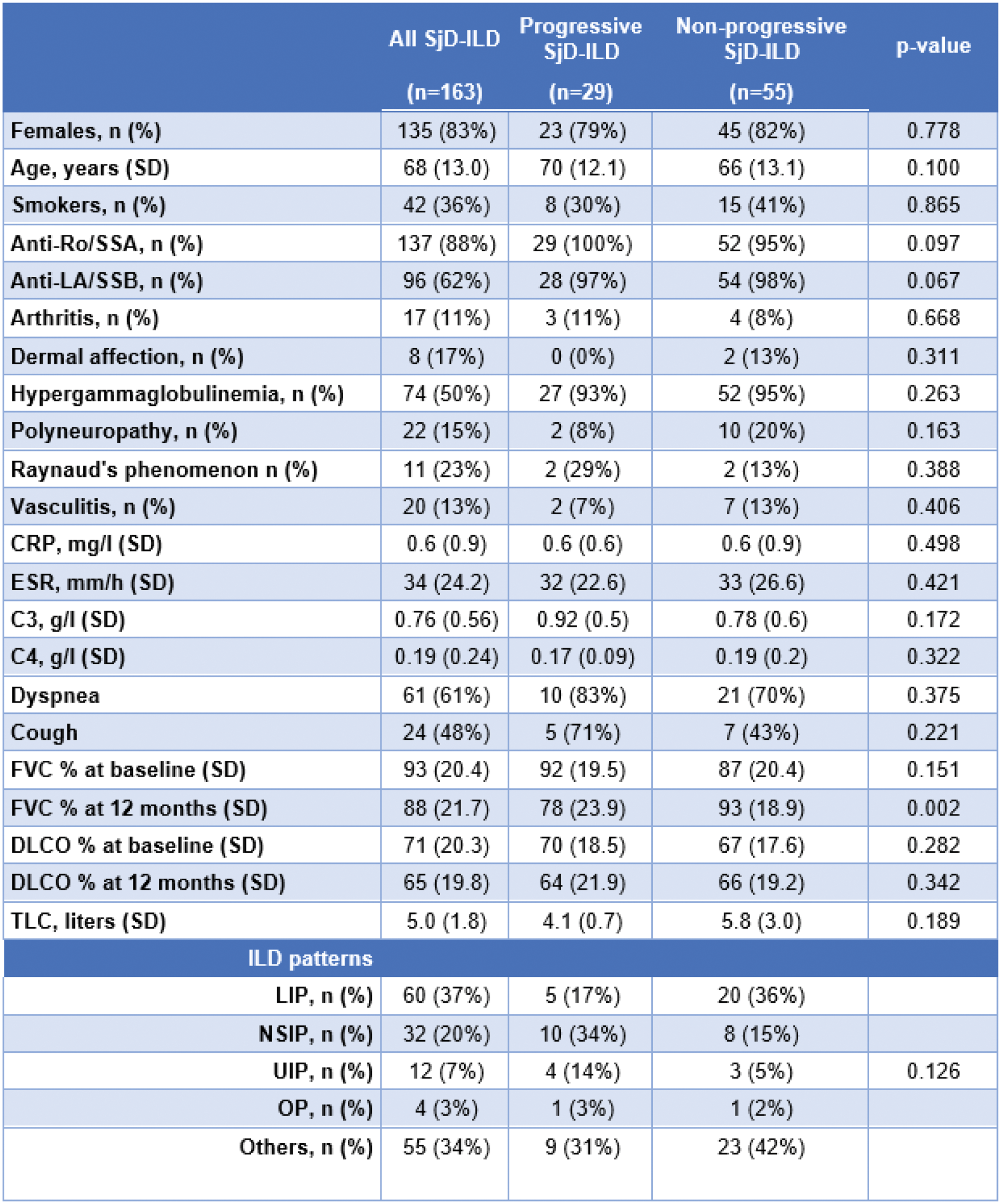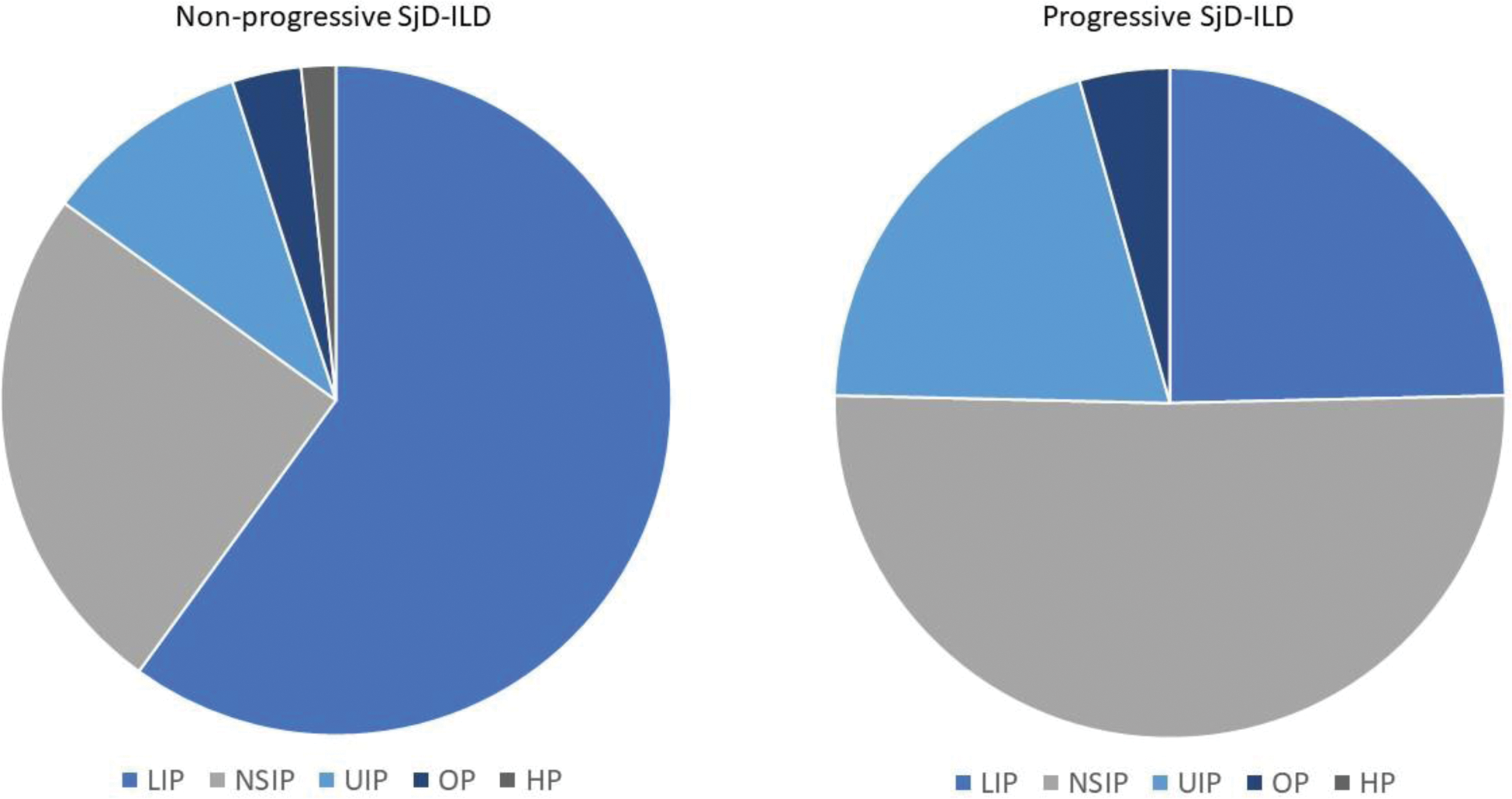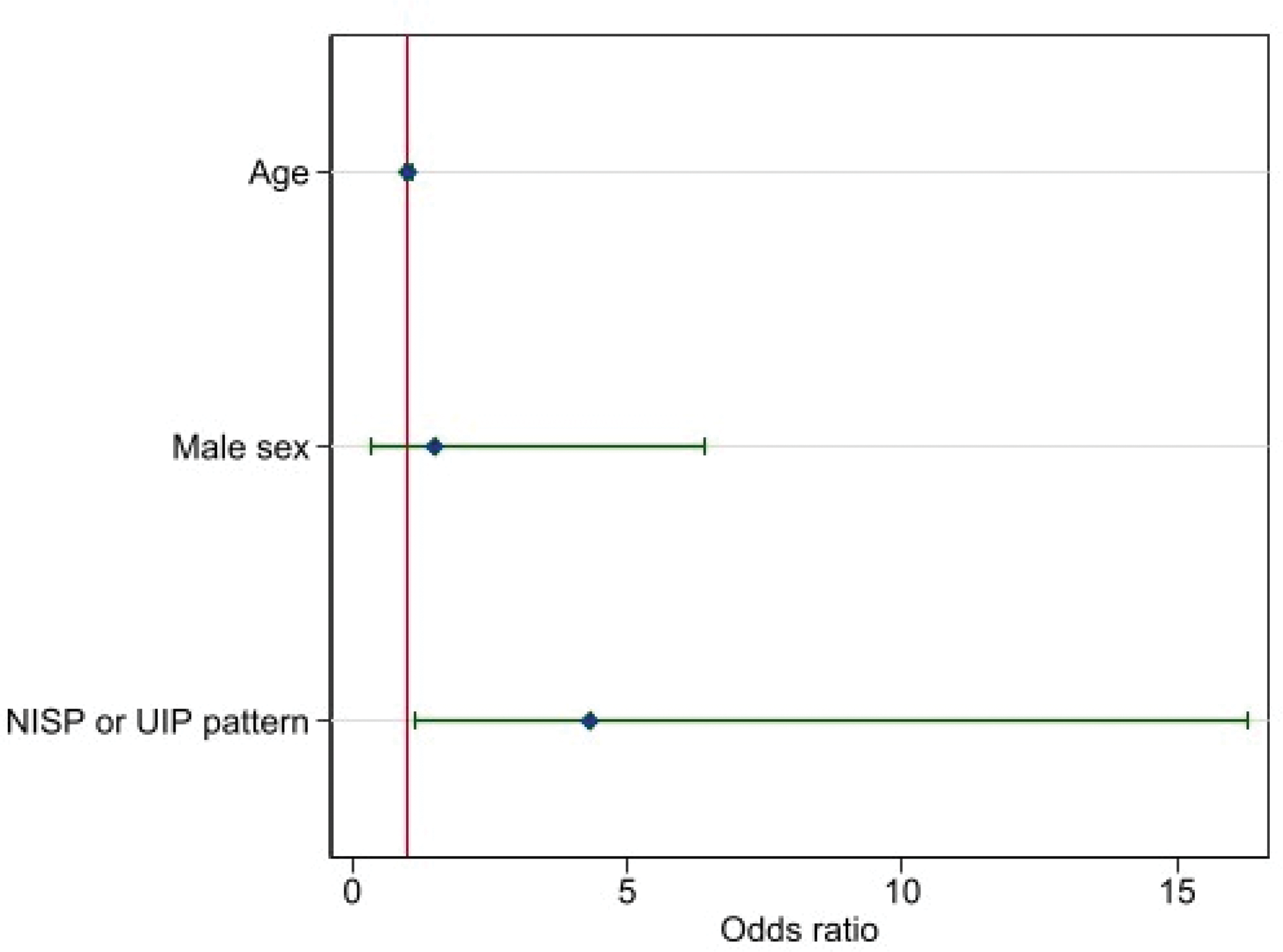

Background: Interstitial lung disease associated with Sjögren’s disease (SjD-ILD) is linked to increased morbidity and mortality. The clinical course varies widely, ranging from stable to progressive disease that may necessitate lung transplantation. Identifying patients at risk of progression is therefore important to optimize disease management before lung damage occurs, aiming to improve outcome. However, clinical and biological parameters reliably predicting disease progression remain insufficiently understood.
Objectives: To assess risk factors for ILD progression in SjD within a multicenter European cohort.
Methods: In this prospective, international cohort study, patients with SjD and an associated ILD diagnosis confirmed by expert radiologists on high-resolution computed tomography (HRCT) from three European expert rheumatology centers (Zurich, Oslo, Vienna) were included. Comprehensive clinical, serological, and laboratory data, along with pulmonary function tests, including forced vital capacity (FVC) and diffusing capacity of the lungs for carbon monoxide (DLCO), were collected. ILD patterns on HRCT were assessed by expert radiologists and included nonspecific interstitial pneumonia (NSIP), lymphoid interstitial pneumonia (LIP), usual interstitial pneumonia (UIP), organizing pneumonia (OP), and others. ILD progression was defined as an absolute FVC decline of ≥5% over 12 ± 6 months. Clinical and biological parameters were analyzed as risk factors for disease progression using uni- and multivariable logistic regression, adjusted for age and sex. Model performance was tested by the area under the curve (AUC), with values >0.7 considered as acceptable.
Results: We identified 163 patients with SjD-ILD, of whom 84 (52%) had 12±6-month follow-up FVC data assessment (Table 1). Of these, 29 patients (34.5%) showed ILD progression. Among progressors, the mean FVC declined from 92% (SD 19.5) to 78% (SD 23.9), whereas non-progressors showed slight improvement from 87% (SD 20.4) to 93% (SD 18.9). No statistically significant differences in clinical or biological parameters were observed between progressors and non-progressors. While there were no significant differences in HRCT patterns between groups, progressive patients showed numerically higher rates of NSIP and UIP patterns. Notably, even patients with LIP experienced ILD progression in 17% of cases over 12 ±6 months. When evaluating predictors of ILD progression, demographic characteristics, SjD-specific features, and baseline lung function tests were not identified as significant risk factors. However, the presence of cough (OR 9.5, 95% CI 1.14–76.68, p=0.030) and NSIP or UIP patterns (OR 5.0, 95% CI 1.45–17.27, p=0.011) emerged as significant predictors in both univariable and multivariable logistic regression analyses (Figure 1B), with acceptable AUC values (AUC=0.71).
Conclusion: ILD frequently progresses in patients with SjD. However, identifying patients at risk for progression remains challenging. Importantly, while NSIP and UIP patterns emerged as the strongest risk factors for progression, a substantial proportion of patients with LIP also showed progression over a short follow-up period. These findings underscore the need for close monitoring of all patients with SjD-ILD to optimize management and improve outcomes.
REFERENCES: NIL.
Table 1. Characteristics of patients with SjD-ILD. Values displayed as absolute numbers (%) or mean (Standard Deviation) as indicated.

Distribution of ILD pattern on HRCT in patients with stable and progressive SjD-ILD.

Risk factors for ILD progression in SjD-ILD using multivariable logistic regression (AUC=0.71).

Acknowledgements: NIL.
Disclosure of Interests: Marco Sprecher AbbVie, Kastriot Kastrati: None declared, Dr. Cosimo Bruni Boehringer Ingelheim, Novartis Foundation for medical-biological research, EMDO Foundation, Iten-Kohaut Foundation. Educational grants from Wellcome Trust. Congress support from Boehringer-Ingelheim, Hartmann-Muller Foundation, Bojana Müller-Durovic Swiss Science Foundation, Goldscmidt-Jacobson Foundation, Novartis Foundation for Biological-Medical Research, Iten-Kohaut Foundation and UniScientia Foundation. Conference support by Johnson&Johnson, Thomas Frauenfelder Bayer, Christian Clarenbach Boehringer Ingelheim, Roche, Boehringer Ingelheim, Roche, Emily Langballe Boehringer-Ingelheim, Håvard Fretheim Boehringer Ingelheim, payments made to institution, Natasha Moe Boehringer Ingelheim, Helena Andersson: None declared, Phuong Phuong Diep Boehringer-Ingelheim, Attended advisory board meeting with NordicInfu Care AB, Boehringer-Ingelheim, Øyvind Molberg: None declared, Cathrine Brunborg: None declared, Trond Mogens Aaløkken: None declared, Paul Studenic AbbVie, Helmut Prosch AstraZeneca, BMS, Boehringer Ingelheim, Bracco, Daiichi Sankyo, Janssen, MSD, Novartis, Roche, Sanofi, Siemens Healthineers, Takeda, BMS, Boehringer Ingelheim, Janssen, MSD, Roche, Sanofi, Boehringer Ingelheim, AstraZeneca, Siemens Healthineers and the Christian Doppler Research Association, EU Commission (EU4Health, Horizon Europe Health). Travel grants: Boehringer Ingelheim, Helga Lechner-Radner Abbvie, Gilead, Janssen, Merck-Sharp, Pfizer, UCB-Pharma, Abbvie, Gilead, Janssen, Merck-Sharp, Pfizer, UCB-Pharma, Oliver Distler 4P-Pharma, Abbvie, Acceleron, Acepodia Biotech, Aera, Alcimed, Altavant, Amgen, AnaMar, Anaveon AG, Argenx, AstraZeneca, Blade, Bayer, Boehringer Ingelheim, Calluna (Arxx), Cantargia AB, Catalyze Capital, Corbus, CSL Behring, Galderma, Galapagos, Glenmark, Gossamer, Horizon, Janssen, Kymera, Lupin, Medscape, MSD Merck, Miltenyi Biotec, Mitsubishi Tanabe, Nkarta Inc., Novartis, Orion, Pilan, Prometheus, Quell, Redxpharma, Roivant, EMD Serono, Topadur and UCB, Patent issued “mir-29 for the treatment of systemic sclerosis” (US8247389, EP2331143), 4P-Pharma, Abbvie, Acceleron, Acepodia Biotech, Aera, Alcimed, Altavant, Amgen, AnaMar, Anaveon AG, Argenx, AstraZeneca, Blade, Bayer, Boehringer Ingelheim, Calluna (Arxx), Cantargia AB, Catalyze Capital, Corbus, CSL Behring, Galderma, Galapagos, Glenmark, Gossamer, Horizon, Janssen, Kymera, Lupin, Medscape, MSD Merck, Miltenyi Biotec, Mitsubishi Tanabe, Nkarta Inc., Novartis, Orion, Pilan, Prometheus, Quell, Redxpharma, Roivant, EMD Serono, Topadur and UCB, BI, Kymera, Mitsubishi Tanabe, UCB, Anna-Maria Hoffmann-Vold Boehringer Ingelheim, Janssen, Medscape, Merck Sharp & Dohme, Novartis and Roche, Abbvie, ARXX, Boehringer Ingelheim, Bristol Myers Squibb, Genentech, Janssen, Medscape, Merck Sharp & Dohme, Pliant therapeutics, Roche and Werfen, Boehringer Ingelheim, Janssen.
© The Authors 2025. This abstract is an open access article published in Annals of Rheumatic Diseases under the CC BY-NC-ND license (